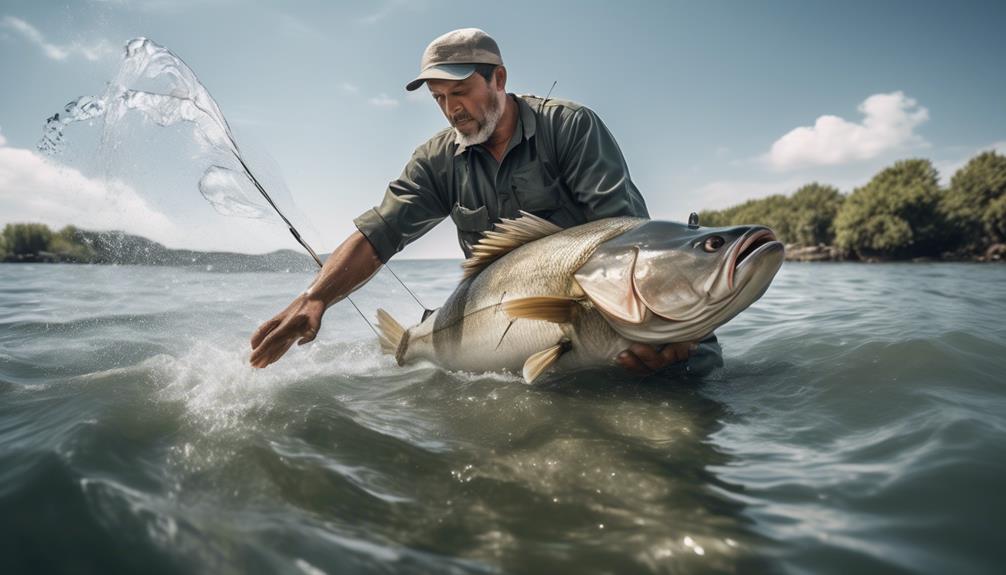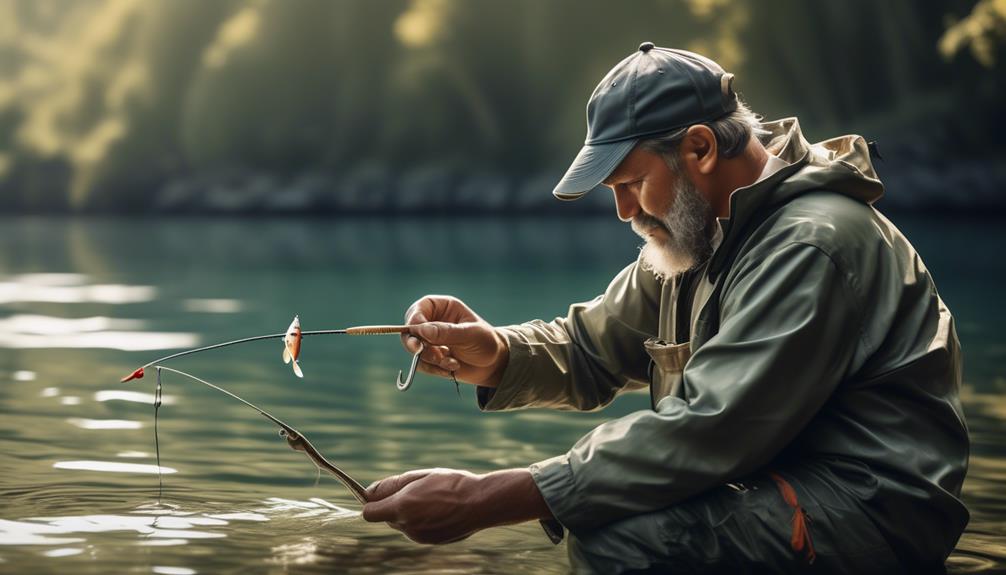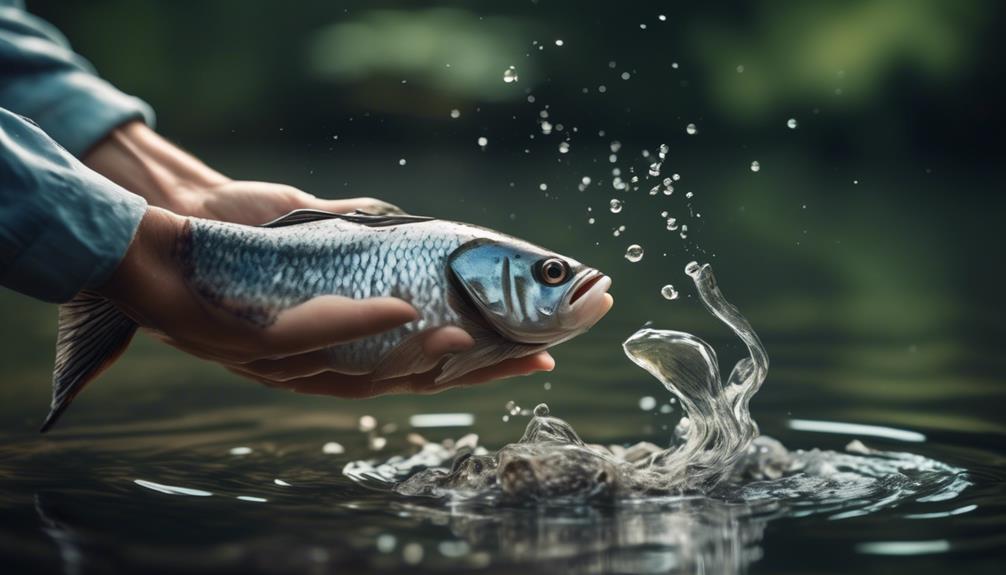When it comes to catch and release fishing, it's like tending a delicate garden – every action you take can either nurture or harm the ecosystem.
You might be familiar with the concept of catch and release, but are you truly implementing the best practices to ensure the well-being of the fish you catch?
There are crucial techniques and considerations that, when followed, can make a significant difference in the survival and health of the fish.
Let's explore the essential steps that will not only elevate your fishing experience but also contribute to the conservation of aquatic life.
Proper Handling Techniques
To ensure the well-being of the fish you catch and release, it's crucial to handle them properly using gentle and efficient techniques. Stress reduction is a key factor in ensuring the survival of the fish after release.
When you catch a fish, it's important to minimize stress by handling it with care. Avoid squeezing the fish tightly or touching its gills as this can impair its ability to breathe. Instead, wet your hands before handling the fish to help protect its delicate skin and scales. Proper grip is essential for minimizing stress on the fish.
When holding the fish, support its body gently but firmly, ensuring that it's fully submerged in the water. This helps to reduce the risk of injury and stress to the fish, increasing its chances of survival after release.
In addition to stress reduction, using the proper grip when handling a fish also ensures your safety. Some fish have sharp spines or teeth that can cause injury if mishandled. By using a proper grip, you minimize the risk of getting hurt while also safeguarding the fish from unnecessary harm.
Selecting the Right Gear
When selecting the right gear for catch and release fishing, consider the specific requirements of the fish species and the environment. Ethical angling practices emphasize the importance of using gear that minimizes harm to the fish. Start by ensuring your gear is in good condition through regular maintenance. This includes checking and replacing any worn-out components, such as rusty hooks or frayed lines, to prevent injury to the fish during the catch and release process.
Opt for sustainable materials when choosing your tackle. Look for gear made from eco-friendly and biodegradable materials, such as natural fibers and non-toxic alternatives to lead weights. This helps reduce the environmental impact of fishing and ensures that if any gear is lost or left behind, it will have minimal long-term effects on the ecosystem.
Consider the impact of your tackle choices on the fish. Use barbless hooks to minimize damage and facilitate easier hook removal, reducing stress and injury for the fish. Additionally, select the appropriate gear size and strength for the targeted fish species to ensure a balance between effectively catching the fish and minimizing potential harm during the release.
Hook Removal and Debarbing
Consider using a specialized tool for safe and efficient hook removal, minimizing harm to the fish and ensuring a smooth release process. Using a tool such as a pair of long-nose pliers, hemostats, or a hook removal tool can significantly reduce the time it takes to remove the hook and minimize handling time, which is crucial for fish safety.
- Fish safety: Minimize the time the fish is out of the water by using a specialized tool for hook removal. This helps reduce stress and potential injury to the fish.
- Ethical angling: By using the right tool, you can ensure that the fish is handled with care and released back into the water as quickly as possible. This aligns with the principles of ethical angling, promoting the well-being of the fish population.
- Smooth release process: Using a specialized tool makes the hook removal process efficient, allowing for a quick and smooth release of the fish. This helps to minimize any potential harm to the fish and ensures that it can swim away strongly.
Additionally, consider debarbing your hooks before fishing. This can make the hook removal process easier and less damaging to the fish. Debarbed hooks are easier to remove and cause less trauma to the fish's mouth, promoting fish safety and ethical angling practices.
Understanding Fish Behavior
Understanding fish behavior is essential for successful catch and release fishing, as it allows you to anticipate their movements and minimize handling time, ultimately ensuring the well-being of the fish. Fish, like all living creatures, experience stress. When caught, they can become disoriented and experience an increase in their stress levels. By understanding fish behavior, you can minimize the time they spend out of the water, reducing their stress and increasing their chances of survival after being released.
Fish have predatory instincts that drive their behavior. They're attracted to movement and are more likely to strike at a moving bait or lure. Understanding this behavior can help you optimize your fishing techniques to minimize the time it takes for a fish to take the bait, reducing the overall stress on the fish.
Additionally, recognizing the feeding patterns of different fish species can help you target specific areas and depths, increasing your chances of a successful catch and minimizing the time the fish spends fighting on the line.
Minimizing Fight Time
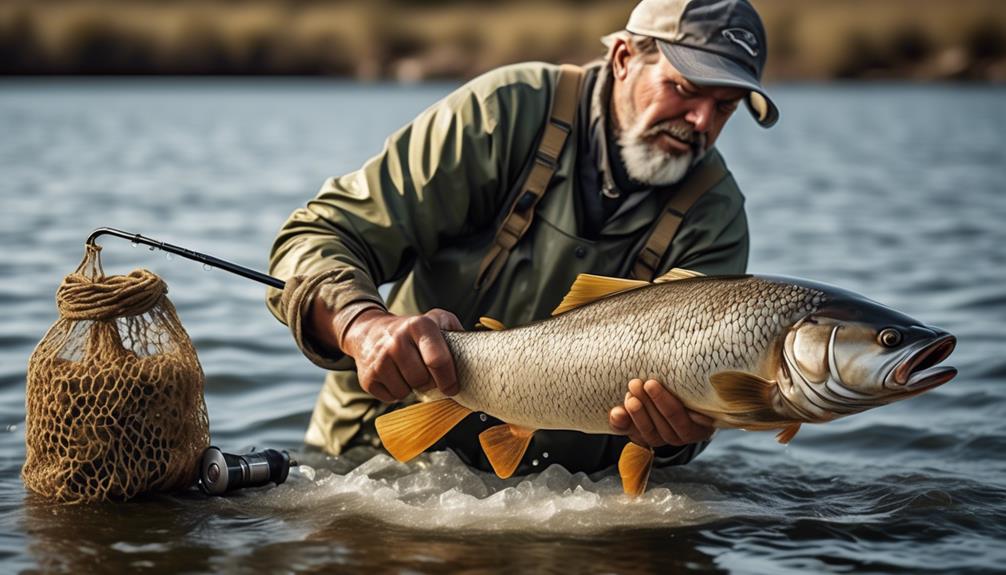
To minimize fight time when catching fish, focus on maintaining tension on the line to tire the fish efficiently. This helps reduce fish stress and improves their chances of survival after being released. When a fish is hooked, it's important to keep the line tight without applying excessive pressure. This allows you to control the fish's movements and wear it out gradually.
To minimize fight time and reduce fish stress, consider the following tips:
- Use the Right Tackle: Opt for the appropriate tackle for the species you're targeting. Using tackle that's too heavy can prolong the fight unnecessarily, causing additional stress to the fish.
- Employ Proper Landing Techniques: Once the fish is tired and ready to be landed, avoid lifting it out of the water with the fishing line. Instead, use a landing net to gently scoop the fish out of the water. This reduces the risk of injury to the fish and minimizes its time out of its natural environment.
- Handle the Fish with Care: After landing the fish, minimize handling as much as possible. Keep the fish in the water while removing the hook, and if you need to handle it, make sure your hands are wet to avoid damaging its protective mucus layer.
Best Practices for Photography
When capturing photos of the fish you've caught, aim to quickly and efficiently snap a few shots before promptly releasing the fish back into the water. Lighting techniques play a crucial role in capturing a stunning photograph. Position yourself so that the natural light is behind you, illuminating the fish and reducing the chance of glare. This will ensure the fish's colors are accurately represented in the photograph. Additionally, framing the photo to highlight the fish while minimizing background distractions will result in a visually appealing image.
Ethical considerations and conservation awareness should always be at the forefront of your mind when taking photos of your catch. Keep in mind that the fish's health and well-being should never be compromised for the sake of a photograph. Be mindful of the time the fish spends out of the water and handle it gently to minimize stress. By practicing catch and release fishing with ethical photography, you contribute to the conservation of fish populations and their habitats.
Reviving and Releasing Fish
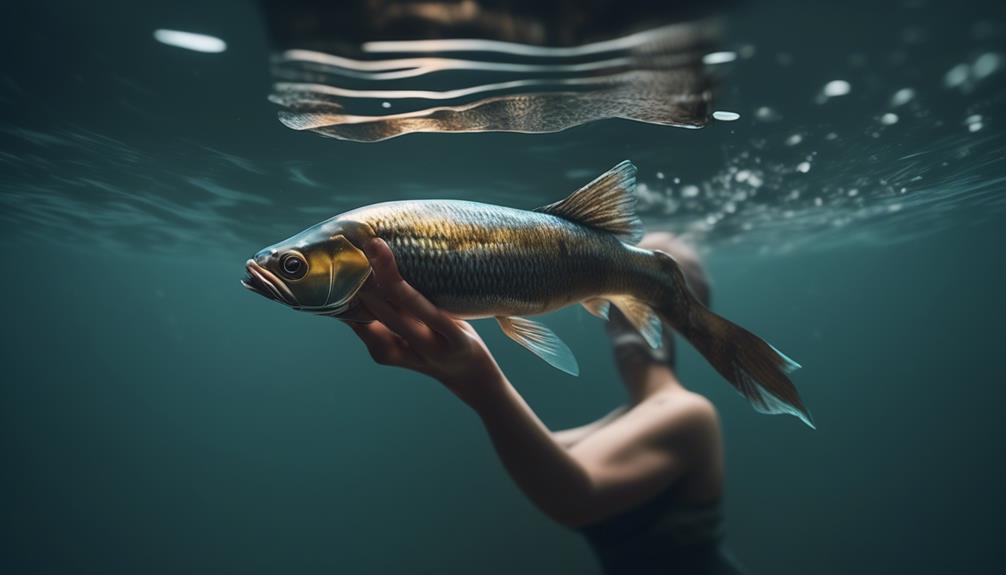
After capturing stunning photographs of your catch, it's crucial to focus on reviving and releasing the fish back into the water. Properly reviving a fish after a tough fight is essential for its survival. Here are some reviving techniques to minimize fish stress and increase their chances of survival:
- Handle with care: Minimize the time the fish spends out of the water. Keep the fish submerged as much as possible, and avoid touching their gills or eyes, as these are sensitive areas.
- Provide support: Hold the fish upright underwater, facing the current if there's any, to help it breathe and regain its strength. You can gently move the fish back and forth to facilitate water flow through its gills.
- Ensure proper release: Once the fish shows signs of recovery, such as trying to swim away or displaying strong movements, gently release it. Avoid throwing the fish back into the water, as this can cause additional stress or injury.
Following appropriate releasing protocols is also crucial to improve survival rates and ensure the fish has the best chance of thriving after being caught. By handling fish carefully and following these techniques, you can contribute to the conservation of fish populations and maintain the joy of catch and release fishing for generations to come.
Monitoring and Reporting Catch Data
Monitoring and reporting catch data is essential for evaluating the impact of catch and release fishing practices on fish populations. Proper data collection and analysis are crucial components of responsible catch and release fishing. By monitoring and reporting catch data, anglers and researchers can gain valuable insights into the impact of conservation efforts on fish populations.
Effective data collection involves recording the species, size, and number of fish caught and released. This information provides essential data for analyzing the effectiveness of catch and release practices and understanding their impact on fish populations. By reporting this data to relevant conservation authorities, anglers contribute to a broader effort to monitor and manage fish populations, ensuring the sustainability of the sport for future generations.
Analyzing catch data allows researchers to assess the effectiveness of catch and release practices in minimizing the impact on fish populations. This analysis can help identify trends and patterns in fish behavior and survival rates after release, leading to informed decisions on conservation strategies. Furthermore, the data collected can contribute to scientific research on fish populations, enabling a better understanding of the overall impact of catch and release fishing on aquatic ecosystems.
Frequently Asked Questions
How Can Catch and Release Fishing Help Conserve Fish Populations?
Catch and release fishing benefits fish populations by conserving their numbers. It has a positive environmental impact by allowing fish to survive and reproduce. Using proper techniques improves the survival rate of released fish.
Additionally, it raises ethical considerations about respecting wildlife. By practicing catch and release, you contribute to the conservation of fish populations, ensuring their sustainability for future generations to enjoy.
What Are the Potential Long-Term Effects of Catch and Release Fishing on Fish Populations?
Catch and release fishing can have both positive and negative effects on fish populations. When done properly, it can support conservation efforts by allowing fish to survive and reproduce.
However, if not practiced carefully, it can lead to decreased survival rates and long-term impacts on population sustainability.
Therefore, understanding and implementing best practices for catch and release fishing are crucial for maintaining healthy fish populations.
Are There Any Specific Regulations or Guidelines for Catch and Release Fishing in Different Regions?
In different regions, regulations and guidelines for catch and release fishing vary. Enforcement of these rules is crucial for the conservation impact on fish populations. Survival rates greatly depend on proper fish handling techniques.
It's important to familiarize yourself with the specific regulations in your area to ensure the well-being of the fish and the sustainability of the practice. Always follow the guidelines to contribute to the preservation of fish populations.
What Are Some Common Mistakes Anglers Make When Practicing Catch and Release Fishing?
When practicing catch and release fishing, common mistakes include improper handling techniques that can harm the fish. It's crucial to avoid excessive handling, keeping the fish out of the water for too long, and using barbed hooks that can injure the fish.
Always wet your hands before handling the fish, support its body properly, and use barbless hooks to minimize harm. Proper handling helps ensure the fish's survival after release.
How Can Anglers Ensure That Released Fish Have the Best Chance of Survival After Being Caught?
To ensure released fish have the best chance of survival, focus on proper releasing techniques. Avoid prolonged handling, use barbless hooks, and keep the fish in the water as much as possible.
Also, be mindful of the environmental impact. Avoid releasing fish in warm water or areas with low oxygen levels.
Conclusion
Now that you know the best practices for catch and release fishing, you can ensure the health and safety of the fish population.
By implementing proper handling techniques, selecting the right gear, and understanding fish behavior, you can minimize the impact of catch and release on the fish.
Remember to always monitor and report catch data, and follow best practices for reviving and releasing fish.
With these tips, you can enjoy fishing while also preserving the environment.
